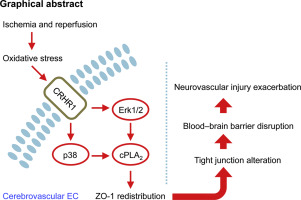当前位置:
X-MOL 学术
›
Cell. Signal.
›
论文详情
Our official English website, www.x-mol.net, welcomes your feedback! (Note: you will need to create a separate account there.)
Activation of CRHR1 contributes to cerebral endothelial barrier impairment via cPLA2 phosphorylation in experimental ischemic stroke.
Cellular Signalling ( IF 4.8 ) Pub Date : 2019-11-09 , DOI: 10.1016/j.cellsig.2019.109467 Changchun Cao 1 , Jun Zhou 2 , Xiaoli Wu 3 , Yuanyuan Qian 2 , Yali Hong 2 , Junyu Mu 2 , Lai Jin 2 , Chao Zhu 2 , Shengnan Li 2
Cellular Signalling ( IF 4.8 ) Pub Date : 2019-11-09 , DOI: 10.1016/j.cellsig.2019.109467 Changchun Cao 1 , Jun Zhou 2 , Xiaoli Wu 3 , Yuanyuan Qian 2 , Yali Hong 2 , Junyu Mu 2 , Lai Jin 2 , Chao Zhu 2 , Shengnan Li 2
Affiliation

|
The activation of corticotrophin-releasing hormone receptor (CRHR) 1 is implicated in neuronal injury in experimental stroke. However, little is known about the relationship between CRHR1 activation and brain endothelial barrier impairment after ischemia and reperfusion (I/R). Recently we have demonstrated that the activation of extracellular signal-regulated kinase (Erk) 1/2 as well as p38 is required for hydrogen peroxide (H2O2)-increased cytosolic phospholipase A2 (cPLA2) phosphorylation in bEnd3 cells. Using this in vitro ischemic-like model, we found that both blockade and interference of CRHR1 inhibited H2O2-enhancd p38, Erk1/2 and cPLA2 phosphorylation and in turn suppressed monolayer hyperpermeability and ZO-1 redistribution. Then using the transient middle cerebral artery occlusion (tMCAO) mouse model, we revealed that CRHR1 antagonist NBI27914 pretreatment attenuated cPLA2 phosphorylation, Evans blue dye (EBD) extravasation, tight junction disruption and mitochondrial cytochrome c release. CRHR1 interference also inhibited cortical vascular hyperpermeability. Furthermore, NBI27914 administration attenuated neurovascular injury. After 30 min MCAO with 7 days reperfusion CRHR1 interference alleviated hippocampal blood-brain barrier (BBB) leakage and improved spatial cognitive dysfunction. Thus, our study demonstrates that during ischemic stroke the activation of endothelial CRHR1 contributes to BBB impairment via cPLA2 phosphorylation.
中文翻译:

在实验性缺血性中风中,CRHR1的激活通过cPLA2磷酸化促进了脑内皮屏障的损害。
促肾上腺皮质激素释放激素受体(CRHR)1的激活与实验性卒中的神经元损伤有关。然而,关于缺血再灌注(I / R)后CRHR1激活与脑内皮屏障损害之间的关系知之甚少。最近,我们证明了bEnd3细胞中过氧化氢(H2O2)增加的胞质磷脂酶A2(cPLA2)磷酸化需要细胞外信号调节激酶(Erk)1/2以及p38的激活。使用这种体外缺血样模型,我们发现CRHR1的阻滞和干扰均抑制H2O2增强的p38,Erk1 / 2和cPLA2磷酸化,进而抑制单层超通透性和ZO-1重新分布。然后使用短暂的大脑中动脉闭塞(tMCAO)小鼠模型,我们发现CRHR1拮抗剂NBI27914预处理可减弱cPLA2磷酸化,伊文思蓝染料(EBD)外渗,紧密连接破坏和线粒体细胞色素c释放。CRHR1干扰还抑制了皮质血管的通透性。此外,NBI27914给药减轻了神经血管损伤。30分钟的MCAO与7天的再灌注后,CRHR1干扰减轻了海马血脑屏障(BBB)的渗漏并改善了空间认知功能障碍。因此,我们的研究表明,在缺血性卒中过程中,内皮CRHR1的激活通过cPLA2磷酸化导致了BBB损伤。CRHR1干扰还抑制了皮质血管的通透性。此外,NBI27914给药减轻了神经血管损伤。30分钟的MCAO与7天的再灌注后,CRHR1干扰减轻了海马血脑屏障(BBB)的渗漏并改善了空间认知功能障碍。因此,我们的研究表明,在缺血性卒中过程中,内皮CRHR1的激活通过cPLA2磷酸化导致了BBB损伤。CRHR1干扰还抑制了皮质血管的通透性。此外,NBI27914给药减轻了神经血管损伤。30分钟的MCAO与7天的再灌注后,CRHR1干扰减轻了海马血脑屏障(BBB)的渗漏并改善了空间认知功能障碍。因此,我们的研究表明,在缺血性卒中过程中,内皮CRHR1的激活通过cPLA2磷酸化导致了BBB损伤。
更新日期:2019-11-11
中文翻译:

在实验性缺血性中风中,CRHR1的激活通过cPLA2磷酸化促进了脑内皮屏障的损害。
促肾上腺皮质激素释放激素受体(CRHR)1的激活与实验性卒中的神经元损伤有关。然而,关于缺血再灌注(I / R)后CRHR1激活与脑内皮屏障损害之间的关系知之甚少。最近,我们证明了bEnd3细胞中过氧化氢(H2O2)增加的胞质磷脂酶A2(cPLA2)磷酸化需要细胞外信号调节激酶(Erk)1/2以及p38的激活。使用这种体外缺血样模型,我们发现CRHR1的阻滞和干扰均抑制H2O2增强的p38,Erk1 / 2和cPLA2磷酸化,进而抑制单层超通透性和ZO-1重新分布。然后使用短暂的大脑中动脉闭塞(tMCAO)小鼠模型,我们发现CRHR1拮抗剂NBI27914预处理可减弱cPLA2磷酸化,伊文思蓝染料(EBD)外渗,紧密连接破坏和线粒体细胞色素c释放。CRHR1干扰还抑制了皮质血管的通透性。此外,NBI27914给药减轻了神经血管损伤。30分钟的MCAO与7天的再灌注后,CRHR1干扰减轻了海马血脑屏障(BBB)的渗漏并改善了空间认知功能障碍。因此,我们的研究表明,在缺血性卒中过程中,内皮CRHR1的激活通过cPLA2磷酸化导致了BBB损伤。CRHR1干扰还抑制了皮质血管的通透性。此外,NBI27914给药减轻了神经血管损伤。30分钟的MCAO与7天的再灌注后,CRHR1干扰减轻了海马血脑屏障(BBB)的渗漏并改善了空间认知功能障碍。因此,我们的研究表明,在缺血性卒中过程中,内皮CRHR1的激活通过cPLA2磷酸化导致了BBB损伤。CRHR1干扰还抑制了皮质血管的通透性。此外,NBI27914给药减轻了神经血管损伤。30分钟的MCAO与7天的再灌注后,CRHR1干扰减轻了海马血脑屏障(BBB)的渗漏并改善了空间认知功能障碍。因此,我们的研究表明,在缺血性卒中过程中,内皮CRHR1的激活通过cPLA2磷酸化导致了BBB损伤。



























 京公网安备 11010802027423号
京公网安备 11010802027423号